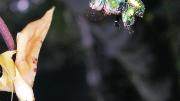Waft the scent of cinnamon, wintergreen, or eucalyptus into the tropical air of Central and South America and beautifully colored bees in hues of red, gold, green, and blue will appear as if out of nowhere, says Stacey Combes, assistant professor of organismic and evolutionary biology. These male orchid bees will travel almost anywhere in pursuit of exotic fragrances—aromatic hydrocarbons that they collect over a lifetime and store in pockets in their massive hind legs. (Like all males in the order Hymenoptera, they have no stingers.)
So powerful a motivator is the orchid bee’s fixation on fragrance (the scents are thought to be used in sexual selection) that it can be used to measure their flying abilities, Combes says. She places a scent in a receptable in front of a fan, and the bees lock on to it. “I can turn the speed up faster and faster, like a treadmill,” she says, “and they keep flying.” She had suspected that once the bees reached maximum flight speed, they wouldn’t be able to keep up anymore, but it was instability they had trouble with. As the speeds increased, the bees started rolling over and were ejected out of the airstream. To prove that turbulence, rather than speed, caused the problem, Combes used a grid with squares to disrupt the airflow and a 3-D sonic anemometer to map the resulting turbulence in the air stream. The higher the turbulence, the lower the bees’ maximum speed before failure.
Combes also observed a counterintuitive behavior: as the speeds increased beyond two meters per second, the bees straightened their hind legs—which increased drag as much as 30 percent. By moving the mass in their legs away from their bodies, Combes explains, the bees increase their moment of inertia, or resistance to rotation, in the same way figure skaters will emerge from a blurringly fast spin by extending their arms. Flying with straight legs requires more energy, but helps the bees stabilize themselves in the turbulent conditions they may encounter in the upper levels of the rainforest, where the orchids they frequent are most abundant.
“Wind is a universal part of life for all flying animals,” says Combes, who is part of a research team working on the development of small-scale mobile robotic devices (see "Tinker, Tailor, Robot, Fly[extra],"January-February 2008, page 8.) “Yet we know remarkably little about how animals navigate windy conditions and unpredictable airflows, since most studies of animal flight have taken place in simplified environments, such as in still air or perfect laminar flows. Our work shows clearly that the effect of environmental turbulence on flight stability is an important and previously unrecognized determinant of flight performance.”









